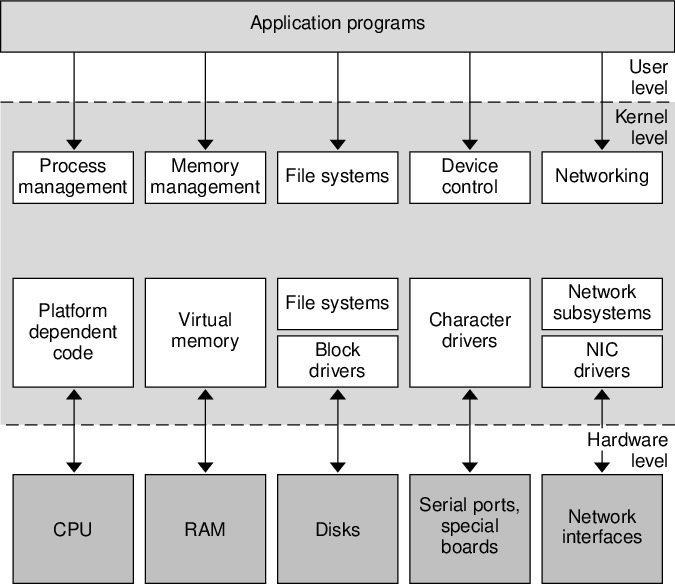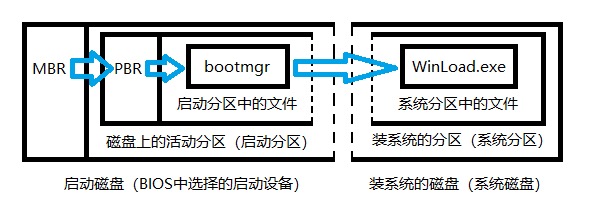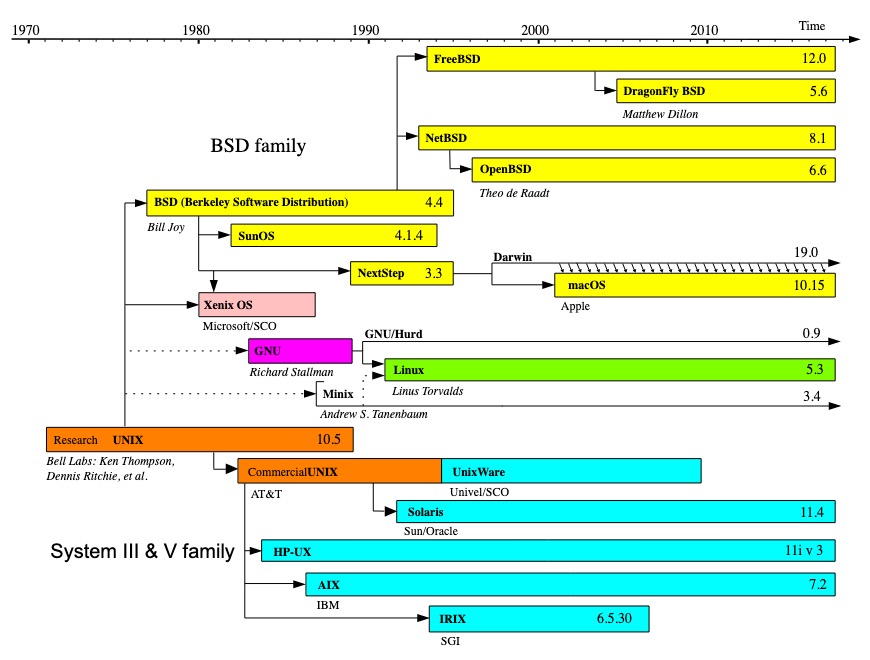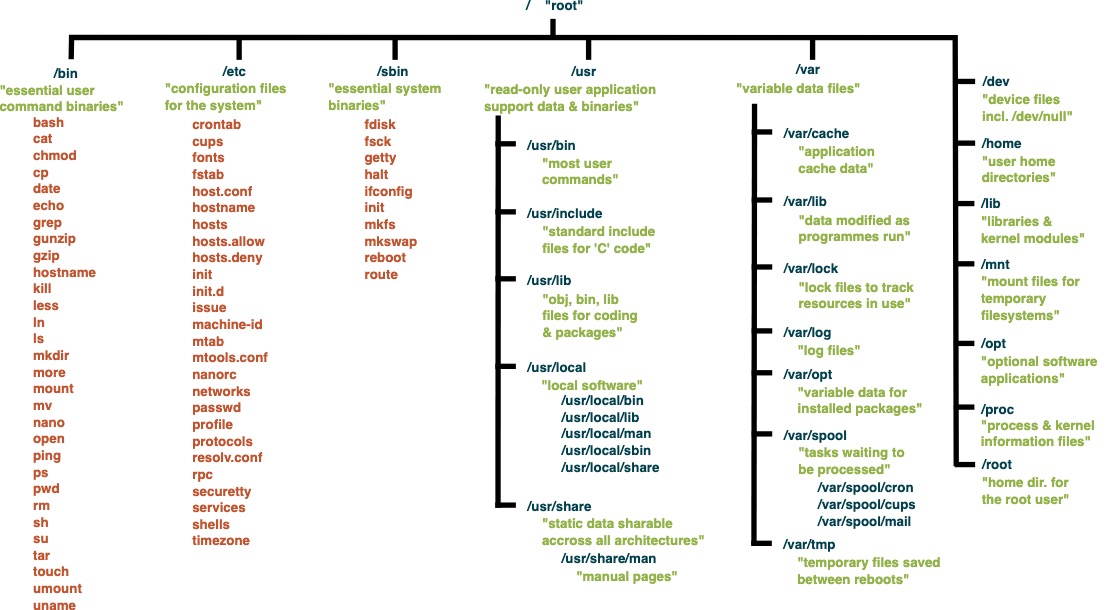linux
What is the difference between Unix, Linux, BSD and GNU?
linux architecture

cpu,ram,disk, device, network;
1. the process of booting
legacy

-
feature: 不知道分区和文件,只能固定读取启动盘的第一个扇区;
-
stage
- stage 1: 通过table 知道分区
- stage 2: 通过引导程序 知道文件系统;;
-
BIOS: basic input outpt system
- check haredware:Power On Self Test (post)
- load and excute bootloader in MRB following the boot sequeuce
-
mbr/GPT: master boot recorder,stage 1
寻找bootable(active) partition
- bootloader code;
- partition list
-
volume boot record: 真正的引导程序,stage 2,加载os
- config
1 2 3 4 5 6 7 8 9#boot=/dev/sda default=0 timeout=5 splashimage=(hd0,0)/boot/grub/splash.xpm.gz hiddenmenu title CentOS (2.6.18-194.el5PAE) root (hd0,0) kernel /boot/vmlinuz-2.6.18-194.el5PAE ro root=LABEL=/ initrd /boot/initrd-2.6.18-194.el5PAE.img - list:
- grub: linux
- config
-
kernel
- start up
- run init program: init programe read
uefi

-
feature:
- 是一个完整的程序,知道各个分区和文件系统,不需要额外中介,直接读取引导程序;
-
how to boot
- 文件启动: 指定明确目录,window manager –> 在 esp partition目录: /EFI/microsoft/boot/bootmgfw.efi
- 设备启动(u盘): 为指定明确目录 boot from usb ,遍历分区,寻找/efi/boot/bootx64.efi
Run level
| ID | Name | Description |
|---|---|---|
| 0 Off | Turns off the device. | |
| 1 | Single-user mode | Mode for administrative tasks. |
| 2 | Multi-user mode | Does not configure network interfaces and does not export networks services |
| 3 | Multi-user mode with networking | Starts the system normally. |
| 4 | Not used/user-definable | For special purposes. |
| 5 | Full mode | Same as runlevel 3 + display manager. |
| 6 | Reboot | Reboots the device. |
init program
the first program start after the kernel booting, it is the ancestor of all other programs
-
SysV-style
-
systemed
1. linux base structure


1. linux distribution constitue components
Kernel + gnu(a set of programs) + windows(optional)
2. system famliy
POSIX: portable operateing system interface

- Bsd and unix are old implementation
- linux is new comer
directory


- /home($HOME | ~): it’s the workspace of a particular user;each user have its own individual files
- /bin: fundamental user program
cat, cp
- /sbin:fundamental system program(run by root) > init, route
- /etc: configure files
- /usr: contain the majority of user utilities and applications;
- /usr/bin: common program
- /user/sbin: common system program
- /usr/local/: local program
go,python…
- /run: runtime variables
- /tmp: maybe delete at any times
- /lib: dynamic library for /bin and /sbin
- /opt optianl application software packagee
- /var
variables data; continually change during normal operation of the system
- /var/run: runtime variables
/var/run/mysqld/mysqld.pid
- /var/log
- /var/run: runtime variables
- /dev: device files: disk,cpu,etc.
1. difference between
/opt vs /usr/local? 1. /usr/local you should mimic the linux hierarchy, seperate your application into different folder /usr/local/bin /usr/local/lib
/usr/local/etc
2. /opt: don't have these restrictions
> e.g.our applications
bin sbin
sbin: used for system administrator bin: used for normal user
/bin, /sbin: essential command
- /bin: ls, cat
- /sbin: iptables, ip
/usr/bin /usr/bin: distribution-manager; not essential
- /usr/bin: awk, sed
- /usr/sbin: httpd ,
/user/local/bin /user/loca/sbin : local-user manager
- /user/local/bin: go
root user
-
what? hava the high privledge;
-
change user: su change to a substitute user,if user is not given, root is asumed
- -, -l: make the shell a login shell
-
/etc/sudoers visudo grant the user root priviliages
formt: user/%group ALL=(ALL) NOPASSWD: command
[run as user/group ]1 2 3 4sys ALL=(ALL) NOPASSWD: ALL # user have root %admin ALL = (ALL) ALL # group have root priviledge rd ALL=(ALL) NOPASSWD: /bin/whoami,/bin/cat,/bin/tail #rd can excute these commnad as root user -
grant the user root priviledge
-
add to group: the wheel group %wheel ALL=(ALL): ALL usermod -aG wheel(sudo) rd
-
grant to the root privilege directly sys ALL=(ALL) NOPASSWD: ALL
-
manager user
/etc/passwd: user info /etc/shaowd: password;; /etc/group:
vipw:edit /etc/passwd safely
- query less /etc/passwd
|
|
- add user
useradd kafka-p: password -m/M: create/notCreate home director
update:
-
change group
1usermod -aG wheel kafka -
update name group home directory
|
|
- delete
userdel username;
- -r: remove home directory and mail
group
-
primary group and secondary group when a new user is created
useradd,
it will create a group which is same name with the user, and will be the primary group of the user -
cat /etc/group
tang❌1001: groupname: password: groupID;
linux signal list
1:hangup 2:interrupt(ctrl+c) 3:quit (ctrl+) 9:kill: cant’t be caught or ignored 15:terminate: software termination signal 18: stop signal generated from keyboard
put a process in background,suspended; can be recoverd by fg command;
job manage
job: a proces from current terminal
- foreground: start process from current terminal
- background:&
- stopped: ctrl+z; bg: bring the job into the background fg: bring the job into the foreground jobs: list all jobs
terminal tty console
terminal and console are both hardware which can interact with a host, basically a keyboard with a display; in the early years, it’s tty;
i/o mutiple
linux directory
/srv: data files for a specific service 如 /srv/www/ftpfile, /srv/indexhtml
/opt: 三方软件不是遵循linux的方式安装的,自己编译的;
/srv 和 /opt都可以部署自己的服务;
如 goApp,
/srv/goApp: 此时goAPP二进制文件可以看做服务特别的数据
/var: 程序允许过程中产生的,如日志,cache;
发行版本
RHEL:
- red hat 维护的或者与其相关的
- 使用yum 安装包
- 代表: rhel, fleodra, cento s
debian
- 开源的
- 使用apt安装
- 代表: debian , ubuntu,
Fedora-> centos stream -> rhel->centos fedora 和stream 都是测试版本, centos 和 rhel都是稳定版本